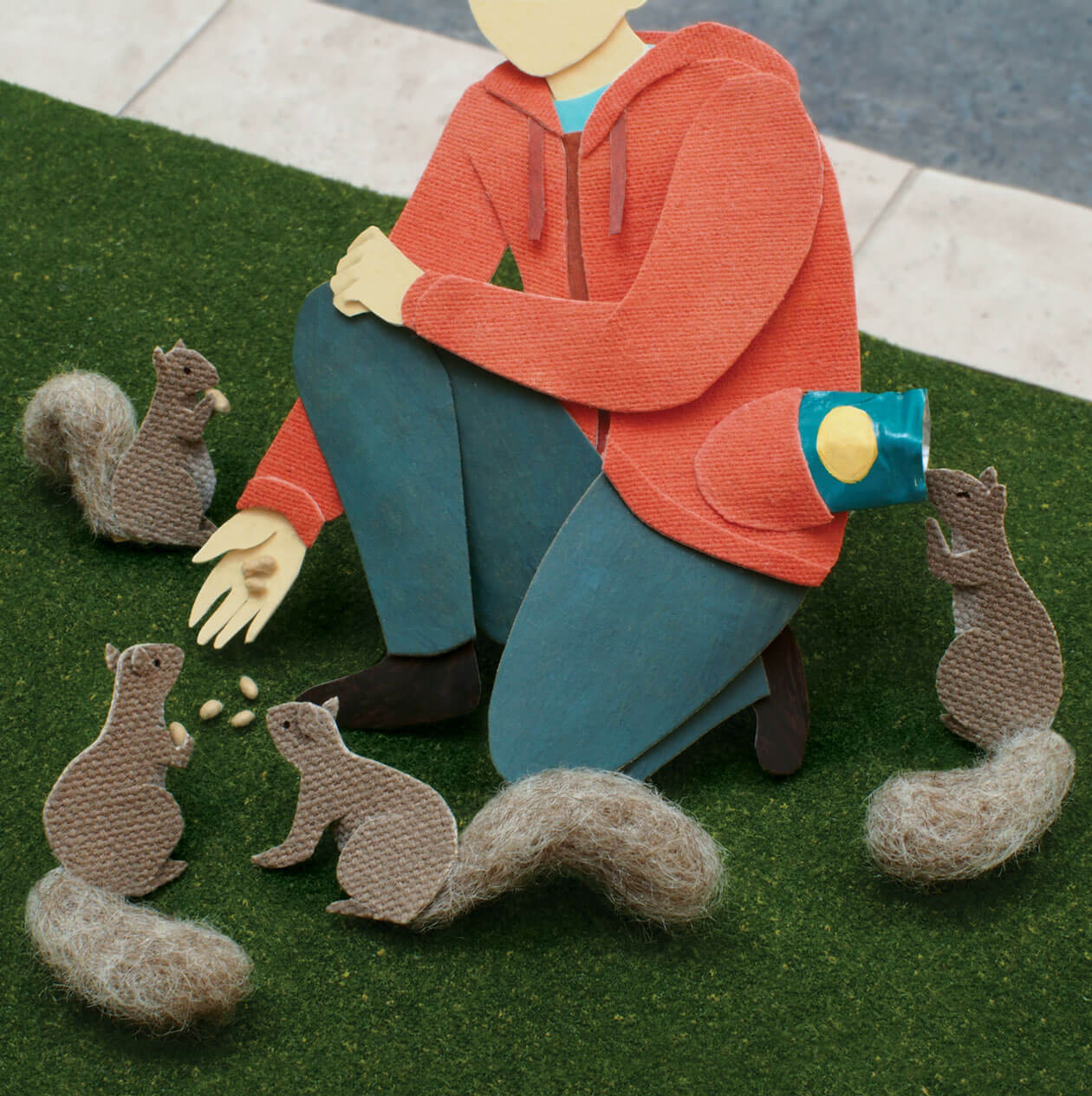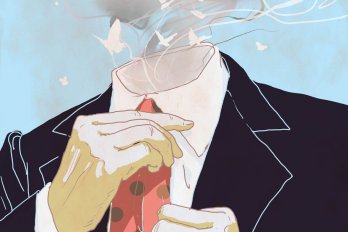Last summer, Colin Garroway, a biology professor at the University of Manitoba, walked into his lab to find his graduate students drinking beer and sewing tiny “straitjackets”—conical bags tightened with Velcro strips—for squirrels. This, Garroway told the students, only half joking, was what a multidisciplinary approach to science was all about.
The jackets, required for an experiment looking into how certain city squirrels differ from their forest cousins, hold the animals still long enough for researchers to sample their DNA and check their size, sex, and general fitness. Garroway’s team is studying a particular species, the eastern grey, which can be identified by its black or grey fur, bushy tail, and fondness for human-built environments.
Once an exclusively woodland creature native to eastern and midwestern North America, eastern greys have come to dominate city and suburban landscapes from coast to coast over the past 200 years. Compared to their forest cousins, they’re more robust, more resilient, and certainly much more comfortable in the company of people. Now Garroway wants to figure out whether these squirrels are changing at a genetic level as well.
The foundation of the eastern grey squirrel’s success is the fact that it’s beloved by humans. It’s controversial to speak of animals as having personalities, but the grey squirrel seems to have one: the creature is curious, charismatic, and—with its big fluffy tail and playful manner—cute.
Starting in the 1840s, cities imported these squirrels to colonize an entirely new type of landscape: public green space. Historian Etienne Benson has documented the beginning of the animal’s expansion across the eastern seaboard; first Philadelphia got squirrels, then Boston, and eventually New York. It was thought that they would beautify parks, and it was also hoped that they would inspire a moral, animal-loving ethos in local citizens.
Squirrels were ideal for these new urban landscapes because they were easily tamed. Before they became ubiquitous in city parks, they were kept as private pets—Benjamin Franklin’s wife even sent an eastern grey squirrel to an acquaintance in England in the 1770s. Later, they became the darlings of naturalists and early environmentalists. American essayist John Burroughs called the squirrel “an elegant creature” that “excites feelings of admiration akin to those awakened by the birds and the fairer forms of nature.” Certainly, people loved feeding them. In one report from the Providence Evening Press, Benson notes, the squirrels of New Haven Green are described as having “become so obese from good living that they are continually missing their hold and falling from tree tops.”
Although there is scant information about the extent of squirrel importation in Canada, Sean Kheraj, a history professor at York University, has found that the practice was at least common enough to support businesses that supplied live squirrels on a continental scale. For his book, Inventing Stanley Park: An Environmental History (2013), Kheraj dug up records from the Vancouver Park Board showing the city purchased eastern greys from a company called Wenz and Mackensen in Yardley, Pennsylvania.
In 1910, when the board decided to stock Stanley Park with new animal inhabitants, it was specifically the “puffier looking grey squirrels” that were desired. The park already had a resident population of Douglas squirrels, but they weren’t “as aesthetically pleasing or in keeping with the expectations of what a park would look like,” notes Kheraj. Wenz and Mackensen sent eight fox squirrels and, later, twelve eastern greys (of which there had been a shortage when the company first received the request). Today, there are so many grey squirrels throughout British Columbia that they’ve begun to displace the native species.
Squirrels and rats have traditionally occupied very different places in human culture and history, despite the fact that they’re both rodents that do well in urban environments. Yet recently, our attitudes toward squirrels have begun to change. As urban squirrels are becoming stronger, more numerous, and less afraid of humans, there are signs our centuries-long experiment may be backfiring. It is easy to spot a tourist in a Canadian town: they are the ones excitedly taking pictures of squirrels, while locals walk past with thinly disguised contempt. Many city dwellers now consider squirrels little more than a common pest. Each spring, the rodents search for warm, dry places to build their nests and have babies. That means chewing through wood, roof shingles, insulation, and even aluminum to get inside attics, garages, and storage nooks.
In fact, Garroway says, squirrels in urban and suburban areas are more likely than those in forests to give birth to second litters each year, because they tend to be fatter and hardier. That’s probably because cities are a few degrees warmer than surrounding areas, and because the squirrels there have access to food sources all year round in the form of trash bags, bird feeders, and, of course, kindly humans.
Urban grey squirrels are also bolder than their forest cousins—something that will come as no surprise to anyone who, on a sunny day, has lunched in a public park and been joined by gatecrashers. This fearlessness has been demonstrated in research that measures “flight distance” in squirrels—essentially, how close a person can get to the animal before it scampers away.
Are these simply adaptive, learned behaviours, or are they related to genetic traits that have developed in squirrels over the past few hundred years? The idea that they could evolve in such a short time frame is not outlandish given what scientists have learned about synanthropic species—those that benefit from living in close association with humans. The main benefit that squirrels—and less friendly animals such as crows, skunks, coyotes, and even bears—get from humans is food. Like us, they’re enthusiastic omnivores that will try just about anything and can adapt their diet to what’s available.
Scientists speculate that squirrels and other wildlife that have managed to hang on and even thrive near modern human settlements aren’t just learning adaptive behaviours—such as those that allow them to navigate busy roads—but passing along genetic traits that wire the next generation for such behaviours. This is what Garroway calls “evolution in real time.”
Among squirrel scientists, for example, there is agreement that so-called black squirrels—which are simply eastern grey squirrels that have black fur—are more commonly found in cities. Amy Newman, a biologist and professor at the University of Guelph, says she has found evidence that melanism may be connected to stress response and immune function—suggesting these kinds of squirrels might be less stressed out in urban environments, which may have contributed to their success. For now, though, she says the relationship between colour and adaptation remains “an interesting mystery.”
Will squirrels stop being cute to us at some point—no longer our (mostly) tolerated neighbours? It’s possible, says Garroway, but he, for one, hopes that squirrels will retain enough of their endearing wildness to remain beloved. “When we’re trapping them in the city, we don’t find them where there’s no trees and no green space,” he says. In some ways, squirrels are actually evidence of the steps we’ve taken to make our urban environments more habitable: not only were they originally introduced to make city life more pleasant, but also the profusion of wildlife wouldn’t be possible in a completely concrete jungle. “It doesn’t have to be parks,” says Garroway, “but it seems like they still need, at least for now, a little bit of nature to persist.” Knowing this, perhaps even those who consider squirrels pests of the highest order could consider them a sign of something else—a green city.
This originally appeared in the June 2017 issue under the headline “Uptown Squirrels.”





